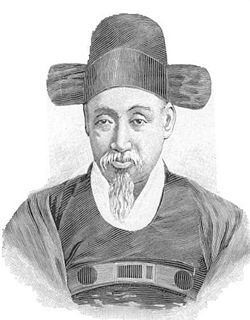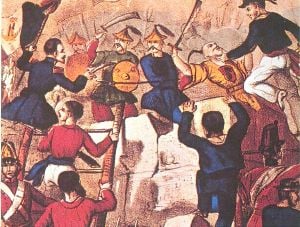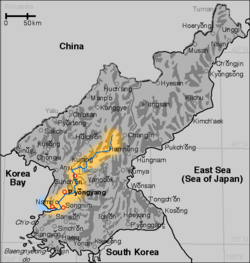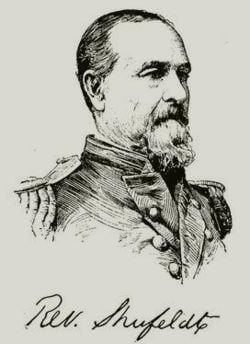General Sherman incident
The General Sherman Incident refers to hostilities between the USS General Sherman and Koreans in Pyongyang, Korea. The battle occured incidential the the General Sherman's mission to attempt to open trade for a British company based in Tientsin, China. Curiously, although the the USS General Sherman hoisted an American flag, and the incident became a cause of concern for the United States government, the captain, Page, and his chief mate, represented the only United States citizens onboard.
Background
Korea during the later years of Joseon Dynasty sought to maintain a low profile. Korea had suffered devasting wars on its soil. In the late 1500s, Japan attacked Ming China by way of the Korean Peninsula, laying waste to the country during two invasions betwee 1592-1598. A few generations later, 1627-1637, the Manchus invaded Korea devasting the nation once again. The Joseon dynasty, inaugurated in 1392, never fully recovered from that one-two punch.
As a result, from the 1640s on, Joseon Korea increasingly depended on their small stature as a protection earning the name "The Hermit Kingdom." The royal court sought to make Korea appear as unattractive as possible from the coast and passed a law that prohibited the return of ship wrecked seaman to their native countries, especially European seamen. As much as possible, Joseon sought to keep the secret of their attractive kindom from the world beyond China. That especially became the case in the mid-1800s when Europe and the United States began to rove East Asia in search of colonies and markets more seriously. From the 1800s, Joseon Korea increasingly sought to conduct all diplomacy with Western nations through China. China, on the other hand, although wanting tribute from Korea, sought to hand off responsibility for Korea's actions, as in the General Sherman incident, to the Koreans.
As early as 1840 Korea had engaged in discussions to open trade relationships with the United States; in 1844 the United States Congress shelved a draft due to lack of interest. The first contact between the US and Korea proved peaceful. In 1853 the USS South America, an American gunboat, visited Busan for ten days and had amiable contact with local Korean officials. Several Americans shipwrecked on Korea in 1855 and 1865 received good treatment, traveling to China for repatriation.
From the 1850s, Korea witnessed the inability of China and Japan to protect themselves from Western navies and armies. Japan opened to trade after Commodore Matthew Perry sailed into Uraga Harbor near Edo (modern Tokyo) on July 8, 1853 and, under the threat of attack, forced Japan to sign the Convention of Kanagawa in 1854. The Joseon court became well aware of the colonization of China and the Opium Wars. That placed Korea in an even more insecure and defensive posture.
China, Japan, and Korea had to decide upon policy to deal with Western superior firepower and armed forces. Either adopt Western technology and ways of government or reject them. Either embrace the new and reject the old, or embrace the old and reject new. From 1854 to 1866, Japan struggled with that issue, deciding to embrace the new with the Meiji Restoration. China and Korea, although in turmoil too over the issue, decided to embrace the old.
The wholesale slaughter of Christians in Korea during the early 1800s constituted a purge of a minority party in the royal court more than an attack on Western influence. In 1866, though, the brutual execution of countless Korean Christians (some accounts name 10,000) by the Daewongun's government clearly constituted an attempt to protect the country from the new, Western influence. The Daewongun's persecution of Catholics, including a number of French Jesuit priests, led to a reprisal by the French that same year. The General Sherman sailed on the scene with that backdrop.
USS General Sherman
Inspite of the tension of recent events in Korea, the British company Meadows and Co. hired the Princess Royal to make at trip to Pyongyang, Korea, in an attempt to meet with Korean officials to begin negotiations for a trade treaty. The 187-ton side-wheel schooner, allegedly heavily armed, carried a cargo of cotton, tin, and glass. Curiously, only Captain Page and Chief Mate Wilson hailed from the United States, the Princess Royal coming under the United States flag with the new name General Sherman just before sailing. In effect, the General Sherman went on the exploratory venture under British initiative, not American. Two other westerner's sailed aboard the General Sherman, the ship's owner, W.B. Preston, a British trader, and Robert Jerman Thomas, a Welsh Protestant missionary obstensibly serving as a translator.[1] The venture hired thirteen Chinese and three Malay crew to handle the ship.
They departed Chefoo (present day Yantai), China on August 6, August 16, or August 18 1866, entering the Taedong River on Korea's west coast sailing towards Pyongyang. The depth of the Taedong River changed frequently due to rains and the tides, but the ship navigated it successfully, stopping at the Keupsa Gate at the border between Pyungan and Hwanghae provinces.
Pyongyang
Local officials then met the crew, communicating well enough to learn the captain wished to promote trade. The Koreans refused trade offers but agreed to provide the crew with some food and provisions. The Koreas told the sailors to wait while higher level government officials could be consulted. The ship departed again, traveling further up river until stranding at Yangjak island near Pyongyang. The governor of Pyongyang then sent his deputy, Lee Hyon-ik, with food and told the captain to wait at the Keupsa Gate while the local officials consulted with the Korean ruler.
Daewongun. At that time Prince Regent, the Daewongun, ruled Korea in the name of his minor son King Gojong. The Daewongun sent orders that the ship must leave immediately or suffer extermination.[1] Several discrepancies on what happened next exist; one eyewitness noted that as Korean troops moved towards the ship, hostile actions followed.
Hostilities Begin
A small boat launched from the General Sherman with six men attempted to reach shore. They captured a Korean named Lee who had pursued them in a small boat. Seeing Lee captive, Koreans soldiers opened fire without hitting their targets. The ship returned fired with its cannons, hitting several and forcing the troops to retreat to safe ground. Fighting continued for the next four days, with a Korean turtle boat dispatched, but causing no damage.
The Koreans then tied several boats together filled with wood, sulphur, and saltpeter. The first two boats failed to inflict any damage, but the third boat set the General Sherman afire. Unable to stem the flames, the crew jumped into the water where Koreans hacked them to death.
Aftermath
The United States returned in 1871 for a punitive action, called the 1871 United States Korea Campaign by Americans and Sinmiyangyo by Koreans, resulting in the deaths of about 350 Koreans. Five years later Korea signed a trade treaty with Japan, and in 1882 signed a treaty with America, ending several centuries of isolationism.
"In 1867, the General Sherman was refloated and brought to a shipyard by Han River. It was refitted and rearmed as Korea's first Western-style warship. But the Chinese government forced the King to give up the ship. US navy archives indicate that the General Sherman was returned to the United States in 1868 or thereabout. It was refitted as a civilian steamship. She sank on January 10, 1874 near Wilmington, North Carolina, in a storm." (Lee Wha Rang, 2000a) The early US-Korea relations Excerpt from "A Brief History of the US-Korea Relations Prior to 1945" Kim Young-Sik, Ph.D. 7/25/2003 [2]
Disputed account
Although the purported reason for the journey was to conduct trade with Korea, the Koreans contend that the actual intention was to find treasure buried in the royal tombs near Pyongyang. Further, the Americans' trade claim is specious as the General Sherman may not have even carried the necessary cargo for trade; the Meadows Company never specified a quantity of cargo in the manifest documents sent to the authorities after the destruction of its schooner. Koreans also felt the use of a heavily armed, tin-plated gunboat belied the desire for peaceful trade.
Notes
- ↑ According to Korean Official history record, "Kojong-silrok"(Vol.3), there are no statement records. The record said " A mob attacked and burned the ship, and let out a whoop of triumph. There were a few survivors who had dived into the river from the prow of ship. They said "Don't kill me," but they were beaten to death. "
See also
- History of Korea
- Joseon Dynasty
- List of Korea-related topics
- French Campaign against Korea, 1866
- United States Korean expedition
ReferencesISBN links support NWE through referral fees
- Cable, E. M. 1938. The United States-Korean relations, 1866-1871. Seoul, Korea: Y.M.C.A. Press. OCLC: 29145170
- Denny, Owen Nickerson, and Robert R. Swartout. 1983. An American adviser in late Yi Korea: the letters of Owen Nickerson Denny. Universiy, AL: University of Alabama Press. ISBN 9780817301897
- Drake, Frederick C. 1984. The empire of the seas: a biography of Rear Admiral Robert Wilson Shufeldt, USN. Honolulu: University of Hawaii Press. ISBN 9780824808464.
- Field, James A. 1962. History of United States Naval operations: Korea. Washington: [U.S. Govt. Print. Off.]. OCLC: 1131205 [3]
- Grimmett, Richard F. 2007. Instances of use of United States Armed Forces abroad, 1798-2006. CRS report for Congress, RL32170. [Washington, D.C.]: Congressional Research Service, Library of Congress. [4]. OCLC: 122348156
- Swartout, Robert R. 1980. Mandarins, gunboats, and power politics: Owen Nickerson Denny and the international rivalries in Korea. Asian studies at Hawaii, no. 25. Honolulu: Asian Studies Program, University of Hawaii. ISBN 9780824806811
- Utz, Curtis A. 1994. Assault from the sea: the amphibious landing at Inchon. The U.S. Navy in the modern world series, no. 2. Washington: Naval Historical Center, Dept. of the Navy. ISBN 9780160452710[5]
External links
- The Hermit Kingdom And the General Sherman Incident. Retrieved September 19, 2007.
- USS General Sherman Incident. Retrieved September 19, 2007.
- Sinking of the General Sherman A US Marine Merchant Ship. Retrieved September 19, 2007.
- The General Sherman Incident of 1866 and Rev. Thomas' Martyrdom. Retrieved September 19, 2007.
- Some Comments on "The General Sherman Incident of 1866 and Rev. Thomas' Martyrdom.". Retrieved September 19, 2007.
- The Strange Sage of the Princess Royal. Retrieved September 19, 2007.
- Naval Historical Center: USS Princess Royal (1863-1865). Retrieved September 19, 2007.
- Association for Asian Research: The early US-Korea relations,Excerpt from "A Brief History of the US-Korea Relations Prior to 1945", Kim Young-Sik, Ph.D. 7/25/2003. Retrieved September 20, 2007.
- The Strength of Korean's military 1866. Retrieved September 25, 2007.
- Capture the Flag. Retrieved September 25, 2007.
Credits
New World Encyclopedia writers and editors rewrote and completed the Wikipedia article in accordance with New World Encyclopedia standards. This article abides by terms of the Creative Commons CC-by-sa 3.0 License (CC-by-sa), which may be used and disseminated with proper attribution. Credit is due under the terms of this license that can reference both the New World Encyclopedia contributors and the selfless volunteer contributors of the Wikimedia Foundation. To cite this article click here for a list of acceptable citing formats.The history of earlier contributions by wikipedians is accessible to researchers here:
The history of this article since it was imported to New World Encyclopedia:
Note: Some restrictions may apply to use of individual images which are separately licensed.



